
A Complete Guide: How To Clean & Maintain Marble Surfaces
A Complete Guide: How To Clean & Maintain Marble Surfaces
An Introduction to Marble and Its Maintenance
The word “marble” derives from the Ancient Greek μάρμαρον (mármaron), meaning "crystalline rock" or "shining stone", possibly from the verb μαρμαίρω (marmaírō), "to flash, sparkle, gleam"—a fitting origin, given marble’s lustrous appearance.
Marble is a metamorphic rock formed through the transformation of limestone under intense heat and pressure. During this long process, minerals such as quartz and mica, enter the stone, resulting in a wide variety of colors, patterns, and veining. Primarily composed of calcite or dolomite, marble features a crystalline texture and is extracted from quarries around the world—especially in Mediterranean countries such as Italy, Greece, Turkey, and Spain.
Each piece of stone – every block of marble is entirely unique, with no two pieces ever alike. Its rich history stretches across centuries, from ancient sculptures and temples to modern construction and architectural designs. But what exactly makes marble such a timeless and widely used material?
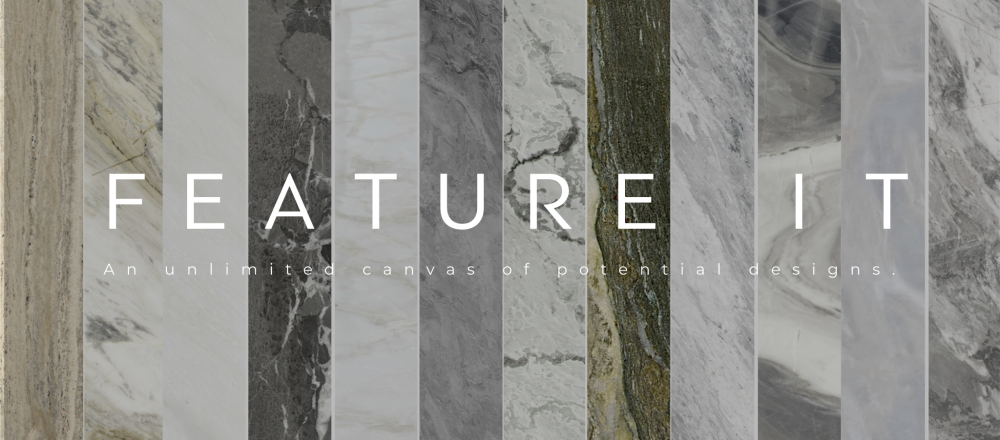
10 + 1 Unique Points To Always Choose Marble For Your Designs
- Classic Beauty: Marble adds character and elegance. It helps create a statement of sophistication that remains in style regardless of the changing design trends.
- Visually Stunning Variety: While often associated with white, marble comes in a broad spectrum of colors due to the presence of various minerals. Shades range from black, pink, and green to beige, red, and blue—or even a combination of colors, making it a great choice for different decor styles.
- Symbol of Luxury: Long regarded as a symbol of refined taste, marble enhances both interior aesthetics and property value, serving as a highly attractive selling point in homes and commercial spaces.
- Naturally cool: Marble has a high heat-resistant capacity, meaning it won't absorb heat energy and stays cool to the touch. This makes it ideal for flooring in warm climates, where it helps lower ambient temperatures. When used for flooring, the natural cooling effect of marble helps regulate body temperature, which leads to improved sleep patterns, improved mood and overall health. When used in countertops, it is ideal for cooking or baking, due to their cool surface.
Environmentally friendly and sustainable: Marble is an environmentally responsible material throughout its lifecycle—from excavation to processing and installation. It requires no harmful chemicals or invasive methods during extraction, and its durability ensures a long lifespan, reducing the need for frequent replacement and minimizing waste. Marble stands out as a material with virtually no negative impact on the environment. Quarry operations are strictly regulated, with mandatory land restoration practices in place. Some quarries even operate underground, eliminating visual and noise pollution for surrounding communities. Additionally, marble waste is minimal, as even remnants are repurposed into mosaics, bricks, or decorative pebbles.
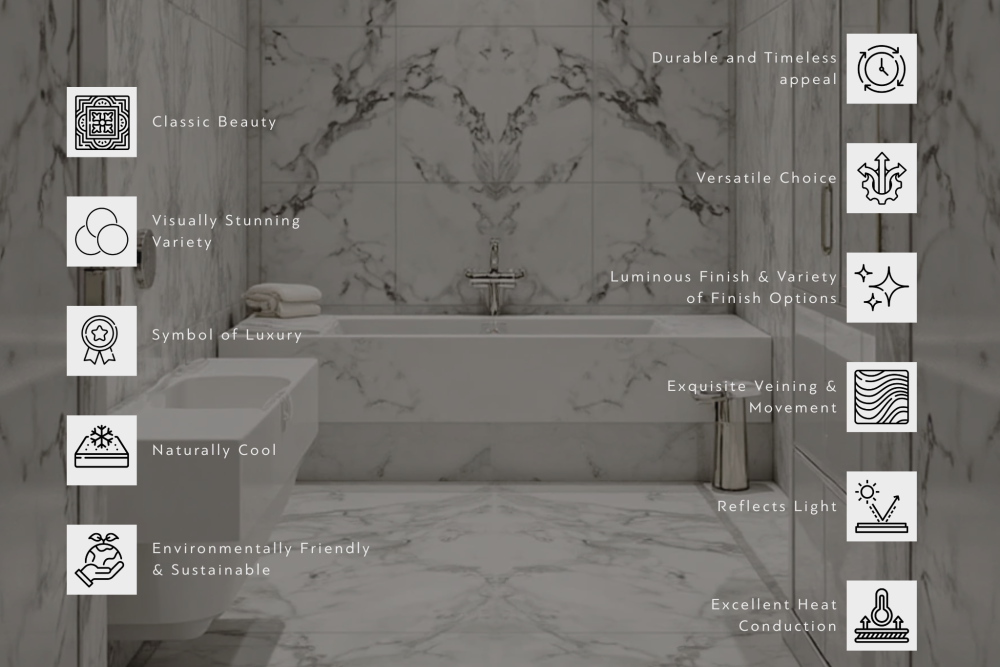
Marble Characteristics
- Durable and Timeless appeal: Marble is renowned for its strength, as evidenced by some of the oldest surviving structures from ancient civilizations, only marble has withstood the test of time for thousands of years. Its natural hardness and resilience make it ideal for long-term use in both architectural and decorative applications
- Versatile: Marble is suitable for both interior and exterior use. Indoors, it enhances spaces with elegance and functionality, commonly featured in shower walls, flooring, kitchen countertops, staircases, and fireplaces. Outdoors, it’s ideal for swimming pool surrounds, building facades, and paving. Its adaptability across various design styles and environments makes marble a preferred choice for architects and designers alike.
- Luminous finish & Variety of Finish options: Marble can be finished in a variety of ways, including polished, honed, bush hammered, and antique, allowing for diverse design options. Polishing creates a more sleek and contemporary aesthetic with its refined appearance.
- Exquisite veining and movement: Because it is not a man-made material, the patterns found vary slightly, resulting in a custom look every single time. The changing pattern offers a distinctive uniqueness and added value. Whether you prefer a bold and dramatic pattern with strong veining or a more subtle one, marble offers a range of aesthetic options that can complement various design styles.
- Reflects Light, adding depth and dimension. Marble’s slightly translucent surface allows it to reflect and diffuse natural light, making spaces feel larger and more welcoming. Some types are even translucent enough to be backlit, creating striking, luminous effects.
Excellent Heat Conduction: Marble is a great conductor of heat, which makes it ideal choice for homes with radiant or in-floor heating, in order to distribute warmth throughout the space.
After exploring the many benefits and versatile uses of marble, one thing is clear—its beauty is truly unmatched. Yet despite its elegance, marble often carries a reputation for being delicate and high-maintenance. But is that reputation entirely deserved? Yes and no. As a natural material, marble does require some care to preserve its charm and keep it looking stunning for decades. In reality, not all types of marble are created equal—variations in density, porosity, and flexibility mean some are more suited to specific applications than others. These differences impact how the stone wears over time and how resistant it is to staining. That’s why selecting the right type of marble for your intended use—and understanding how to care for it properly—is key to ensuring its long-term beauty and performance. This guide offers expert advice and practical tips to help you protect and maintain your marble surfaces. It’s also worth noting that marble is one of the most durable natural materials available and, when chosen and maintained wisely, can even thrive in demanding outdoor environments.
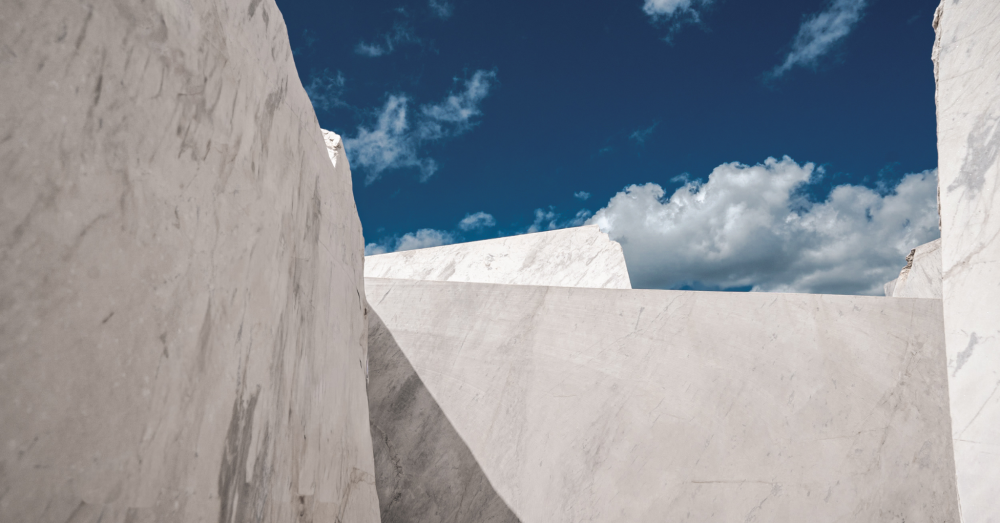
Daily Cleaning: Gentle and Consistent Care
For routine upkeep, always opt for a pH-neutral cleaner mixed with warm water. Harsh chemicals, acidic substances (bleach) , and abrasive pads can cause etching or permanent damage to marble’s surface.
Follow this daily cleaning method:
- Mix a small amount of mild dish soap (non-citrus) into warm water to remove dirt or dust
- Dip a soft microfiber cloth in the solution, wring it out, and wipe the surface gently.
- Rinse the cloth thoroughly and wipe again with clean water to remove soap residue.
- Dry the surface immediately with a soft towel to prevent watermarks.
Key Tips:
- Use microfiber cloths, soft-bristle brushes, soft sponges or towels and dust mops.
- Avoid hard-bristled brushes and scouring pads.
- Immediately blot spills with a soft cloth—never rub, as it spreads the spill.
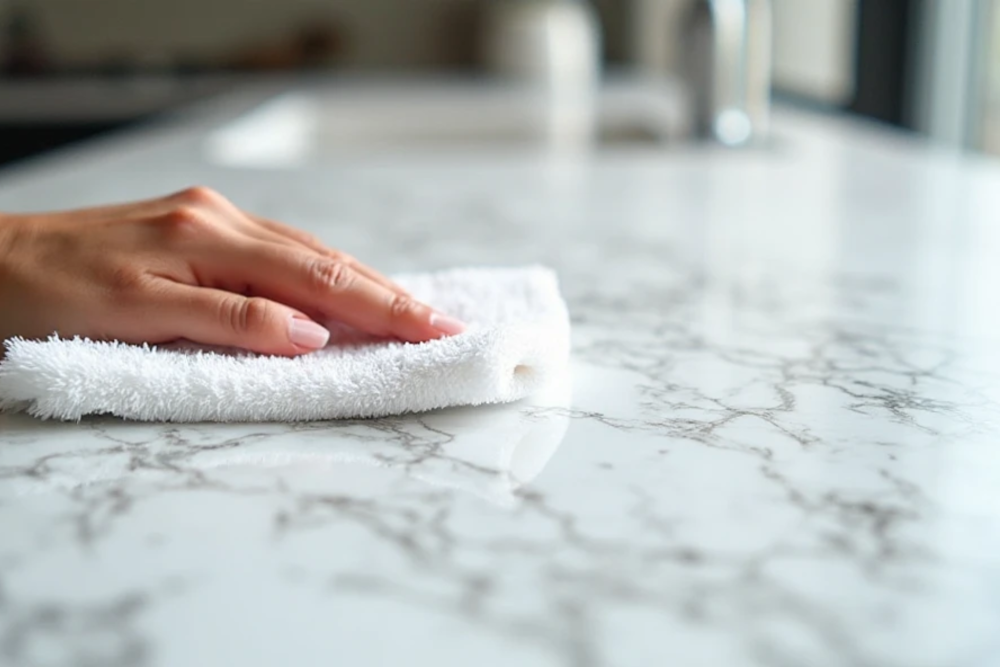
Marble Protective Practices
Spot & Deep Cleaning: Handling Spills and Stains
Spill Response:
Act quickly. Marble is porous and can absorb liquids, leading to stains. Blot (don’t wipe) with a damp cloth and avoid acidic cleaners like vinegar or lemon juice.
Deep Cleaning Solutions:
- Organic stains (wine, coffee, fruit): Create a baking soda and water poultice, apply it to the stain, cover with plastic wrap, and leave it overnight. Rinse and dry thoroughly.
- Oil-based stains (grease, lotions): Mix baking soda with a few drops of mild dish soap and water. Apply, cover, let sit overnight, and rinse.
- Inorganic stains (ink, paint): Use hydrogen peroxide with a few drops of ammonia. Cover the area, allow time to act, then rinse and dry. You may need to reseal the spot.
Sealing & Re-Polishing Marble: Essential for Protection
Marble should be sealed at the time of installation and resealed every few years, depending on usage. The marble will be protected from having dull spots. Look for "dry treat" sealers with smaller molecules that penetrate deeper and offer more protection than traditional sealers. Opt for a high-quality sealer specifically designed for marble and professional application to provide the most effective protection.
Sealing Marble Surfaces
Sealing doesn’t make marble stain-proof but significantly increases its stain resistance. It’s especially vital in kitchens and bathrooms where marble is frequently exposed to moisture and spills.
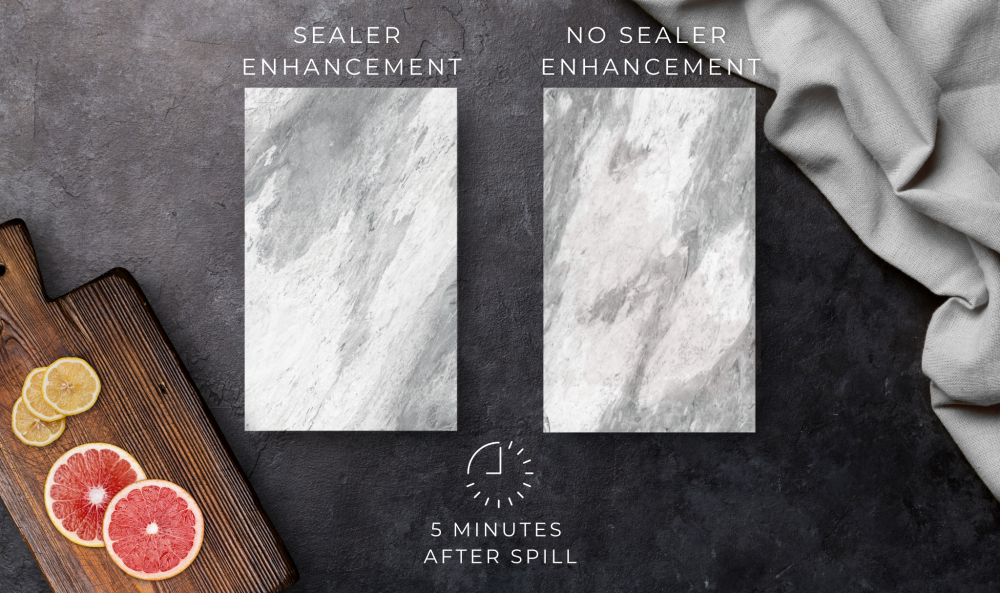
Sealer enhancement provides superior surface protection and long-lasting color clarity.
Polishing &Restoring Shine
Re-Polishing helps maintain the smooth finish and natural luster of marble. You can use a marble-safe polish or gently buff honed marble to blend in etches and restore consistency. Avoid products like linseed or tung oil, which may yellow over time.
Protective Practices: Preventing Damage Before It Starts
- Use coasters under glasses—especially those containing citrus or alcohol.
- Place trivets or mats under hot dishes or cookware to avoid thermal shock.
- Install floor mats at entrances to trap dirt and prevent abrasion on marble flooring.
- Don’t drag heavy items across marble surfaces—this can cause scratches.
- Limit direct sunlight exposure, which can fade marble over time.
- Use honed marble for high-traffic or high-use areas; The mat finish hides etching and scratches better than polished finishes.
- Use rugs in high-traffic areas
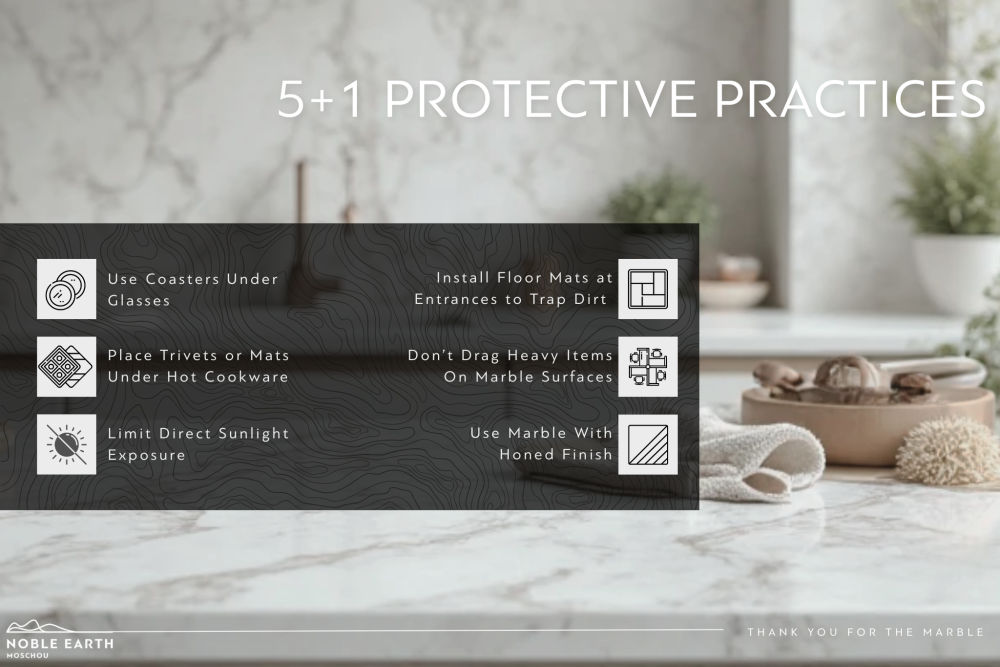
Tailored Care for Specific Areas
Kitchen:
Bathroom:
| Living Areas & Entryways:
Outdoors:
|

Aretusa Marble Living Room
Having explored effective cleaning methods and smart tips to prevent stains, it’s important to remember that cleaning marble with mild soap and warm water is generally a safe bet. During installation, applying a good sealer is essential because marble is typically not an instant stainer—stains occur only when substances are allowed to soak into the surface for hours. As a natural material, marble requires some care, protective habits, and the right products to keep it looking as magnificent as the day it was installed. While it’s not completely maintenance-free, choosing harder or lower absorption marbles along with a quality sealer helps minimize all issues.

